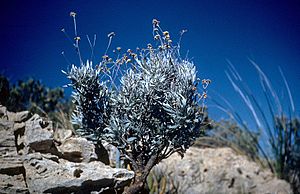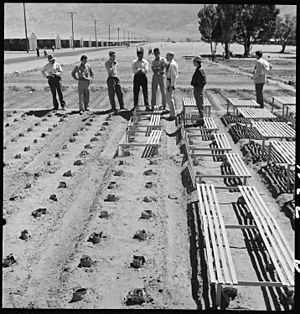Guayule facts for kids
Quick facts for kids Guayule |
|
|---|---|
 |
|
| Scientific classification | |
| Kingdom: | |
| (unranked): | |
| (unranked): | |
| (unranked): | |
| Order: | |
| Family: | |
| Tribe: |
Heliantheae
Cass., 1819
|
| Genus: |
Parthenium
|
| Species: |
P. argentatum
|
| Binomial name | |
| Parthenium argentatum |
|
Parthenium argentatum, often called guayule, is a tough, woody shrub. It grows year after year and is part of the aster family. This plant naturally lives in the Chihuahuan Desert. You can find it in the southwestern United States and northern Mexico.
A scientist named J.M. Bigelow first wrote about guayule in 1852. Another scientist, Asa Gray, officially described it. Guayule is special because it can be used to make many things. These include natural rubber, ethanol (a type of alcohol), and glues that are safe to use. It can also make other special chemicals.
One very important product from guayule is latex. This latex is different from regular rubber from the Hevea plant. Guayule latex is hypoallergenic, meaning it's less likely to cause allergic reactions. Long ago, people in Mesoamerica used guayule for rubber, though less often than another plant called Castilla elastica. The name "guayule" comes from an old word, ulli or olli, which means "rubber" in the Nahuatl language.
Contents
What Guayule Looks Like and Where It Grows
Guayule plants like to grow in sunny, rocky areas in the desert. Their outer branches and leaves have tiny, soft, silver hairs. These hairs are called trichomes. Yellow-white flowers grow from stems at the top of the plant.
The leaves are also covered with a white wax. This wax helps the plant keep water inside, stopping it from drying out. Guayule has a very strong root system. This helps it survive in dry places. It has one main root that goes deep down. Other roots spread out from the main root.
In the U.S., you can find guayule in the Trans-Pecos area of Texas. It also grows in the low deserts of Arizona, New Mexico, and parts of Southern California. In Mexico, it's found in states like Zacatecas, Coahuila, Chihuahua, and Nuevo León. Guayule can also be grown in other parts of the world with similar climates.
Growing and Producing Guayule
Scientists have created special programs to grow guayule better. Their goal is to make it easier to farm and produce more rubber. It's tricky to pick the best guayule plants for breeding. This is because they mostly reproduce by apomixis. This means they make seeds that are exact copies of the parent plant.
Even with this, there is still some natural variety in wild guayule plants. Scientists have been successful in finding and growing types that produce a lot of rubber.
Guayule is perfect for hot desert places. It grows well in sandy, well-drained desert soil. Farmers can grow it with or without extra water. It needs about 380 to 635 millimeters of rain each year. The temperature should usually not drop below -9 degrees Celsius.
Guayule plants make natural bug-fighting chemicals called terpene resins. This helps them resist many pests and diseases. However, young guayule plants grow slowly from seeds. So, farmers sometimes need to use special sprays to help them grow strong.
History of Guayule Use

In the 1920s, people became very interested in guayule. A company in California made a lot of rubber from it. This happened after a plant disease hurt the rubber industry in Brazil.
Guayule became important again during World War II. At that time, Japan stopped America from getting rubber from Malaysia. Guayule was seen as a way to get rubber at home. But the war ended before large guayule farms were set up. It was still cheaper to buy rubber from trees than to get it from guayule plants. So, the project was stopped.
Today, only a few companies like PanAridus and Yulex make guayule rubber for sale. Yulex works with a company called Patagonia. Patagonia now makes wetsuits using a mix of guayule and other materials. This helps them use less traditional rubber.
In 2015, the Bridgestone Corporation announced something exciting. They made the first tires entirely from guayule rubber. They even built a special farm and research center in Arizona to grow guayule.
Why Guayule is Hypoallergenic
In the 1980s, more people started having a type of latex allergy. This happened when more latex gloves were used to stop diseases like AIDS from spreading. Regular rubber from the Hevea tree has proteins that can cause bad allergic reactions. But guayule rubber does not have these proteins.
There are man-made rubbers for medical products. However, they are not as stretchy as natural rubber. Guayule rubber works just like Hevea rubber. But it does not cause the same allergies. In 1997, the United States Department of Agriculture gave a company called Yulex the right to make hypoallergenic guayule latex.
Guayule as Biofuel
Experts are now looking at guayule as a possible source of biofuel. Biofuel is fuel made from plants. Some experts, like Lester R. Brown, say that making biofuel from food crops, like maize, can cause problems. It can make food prices go up. This means people with cars might be competing with people who are hungry.
Guayule can be a good biofuel crop because it is not a food crop. This means it won't make food prices higher. Another great thing about guayule is that it can grow in places where food crops cannot.
See also
 In Spanish: Guayule para niños
In Spanish: Guayule para niños


